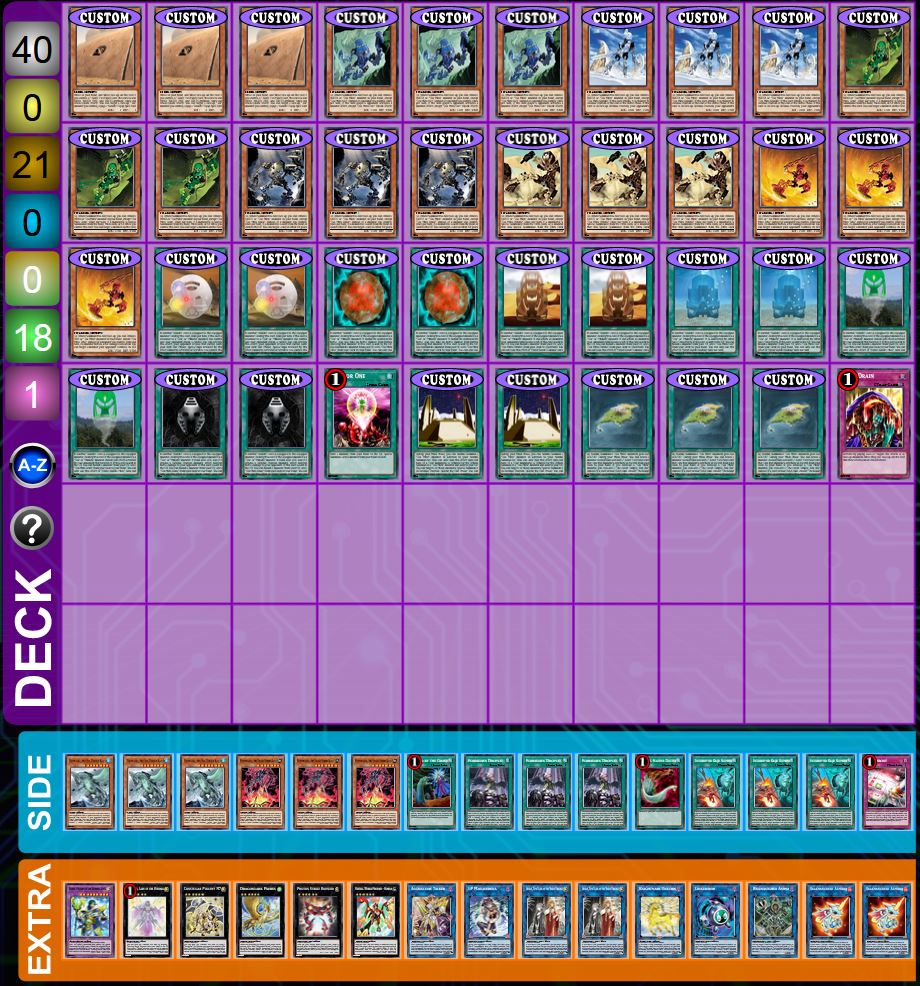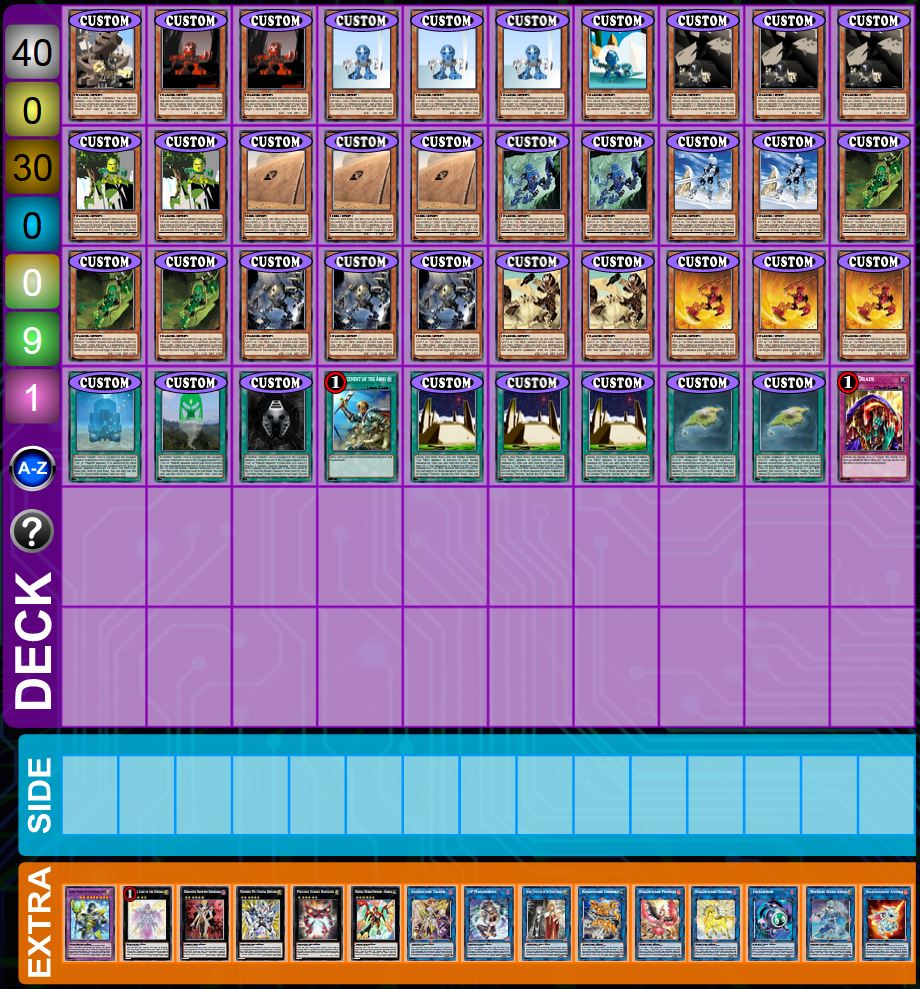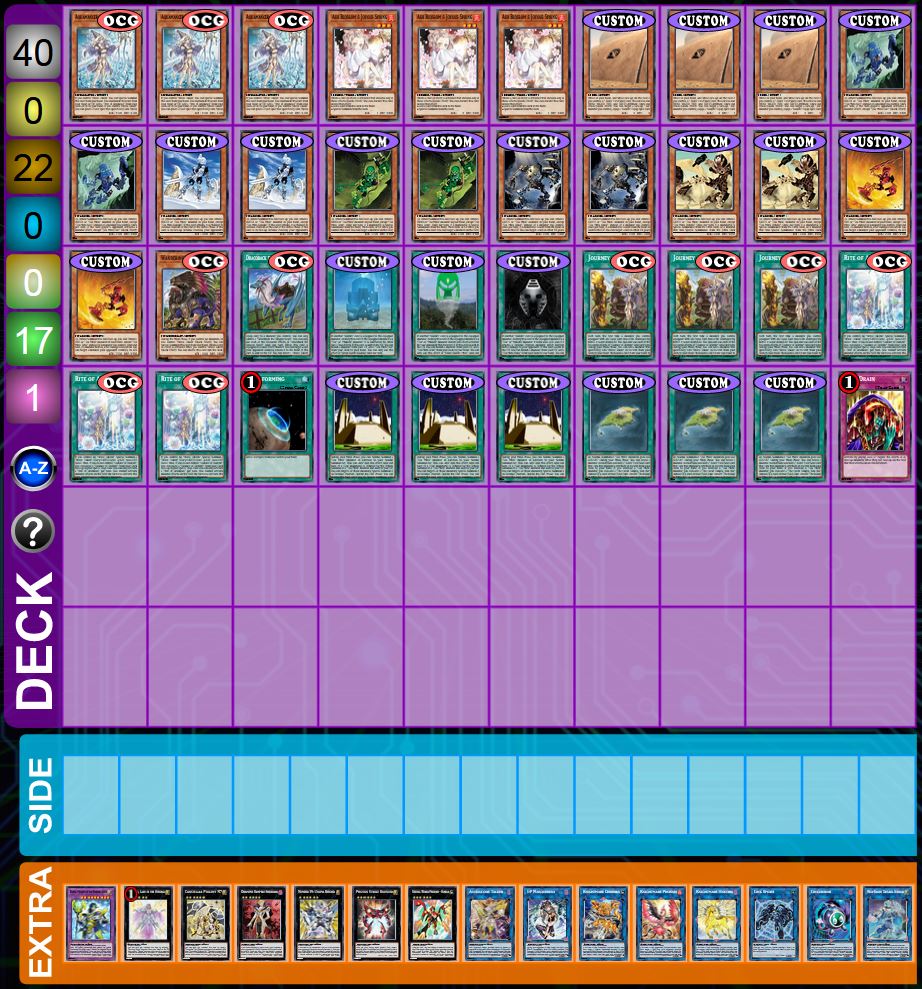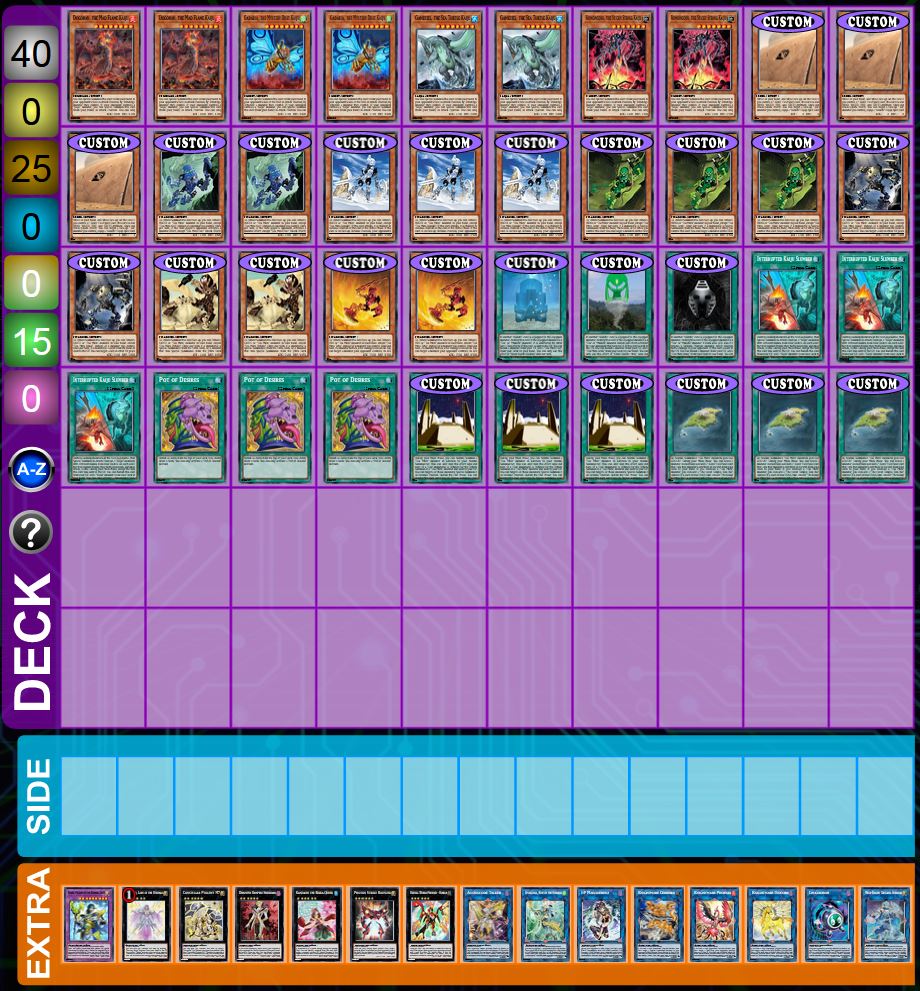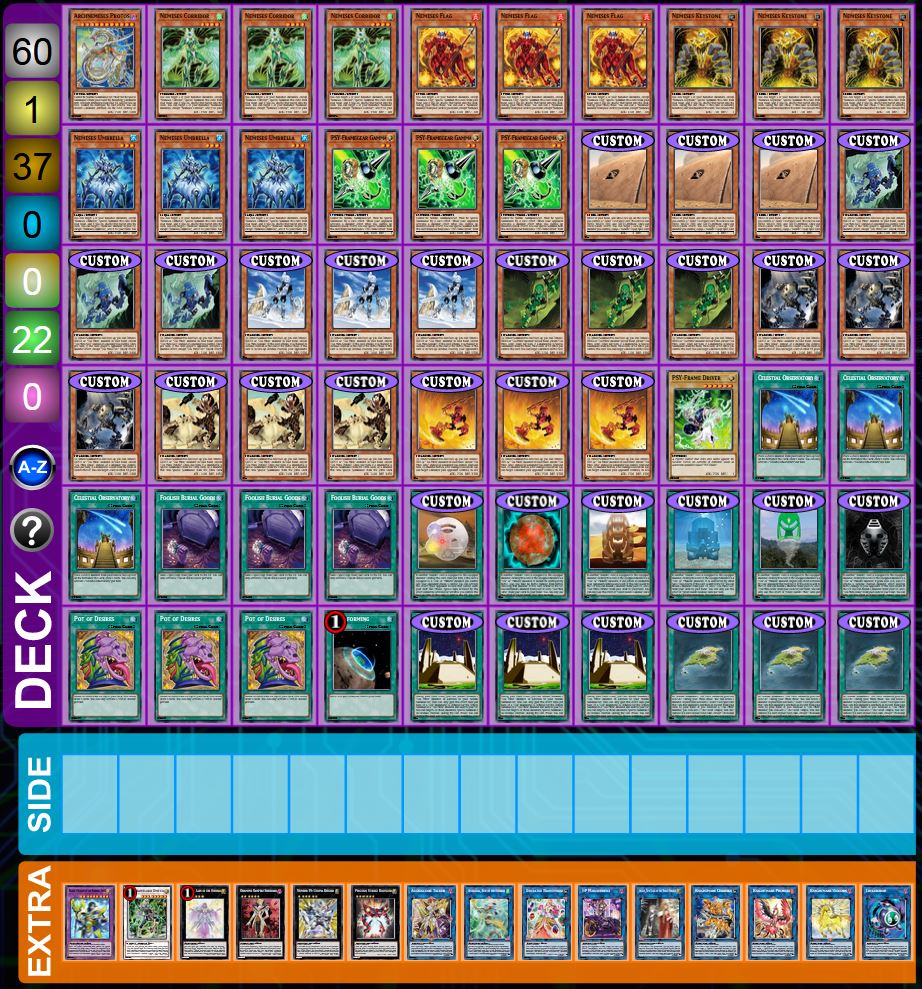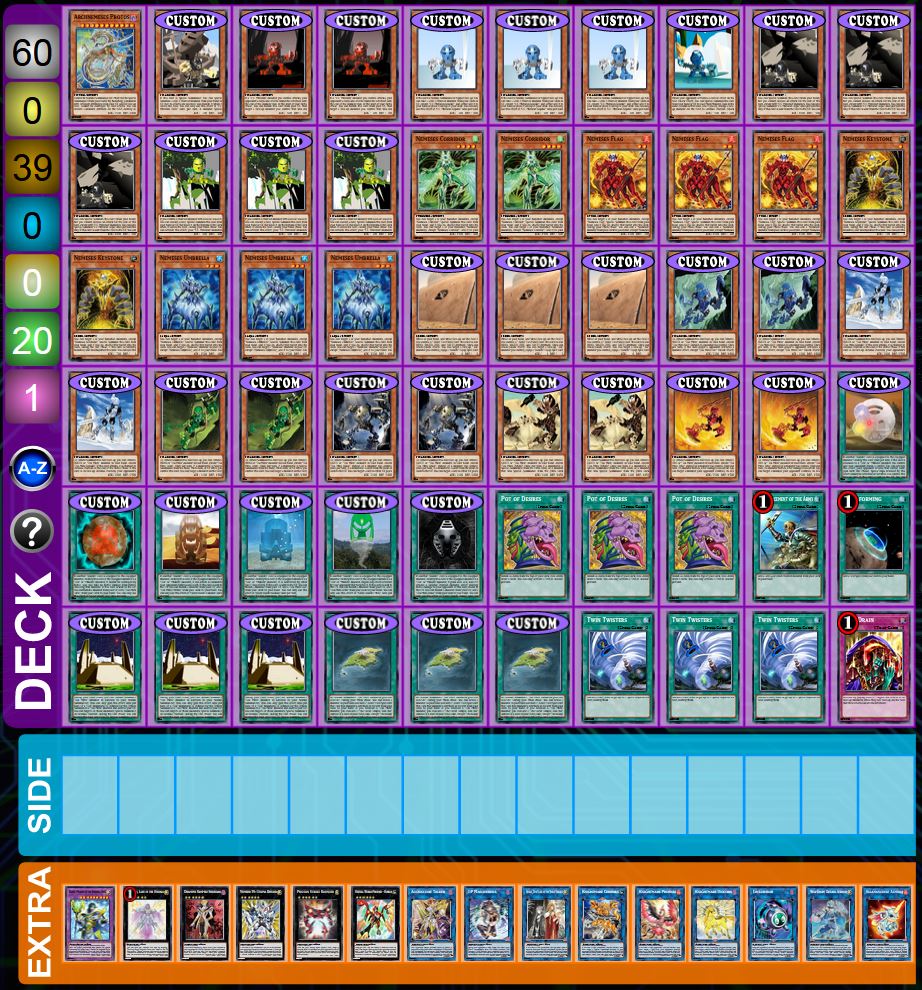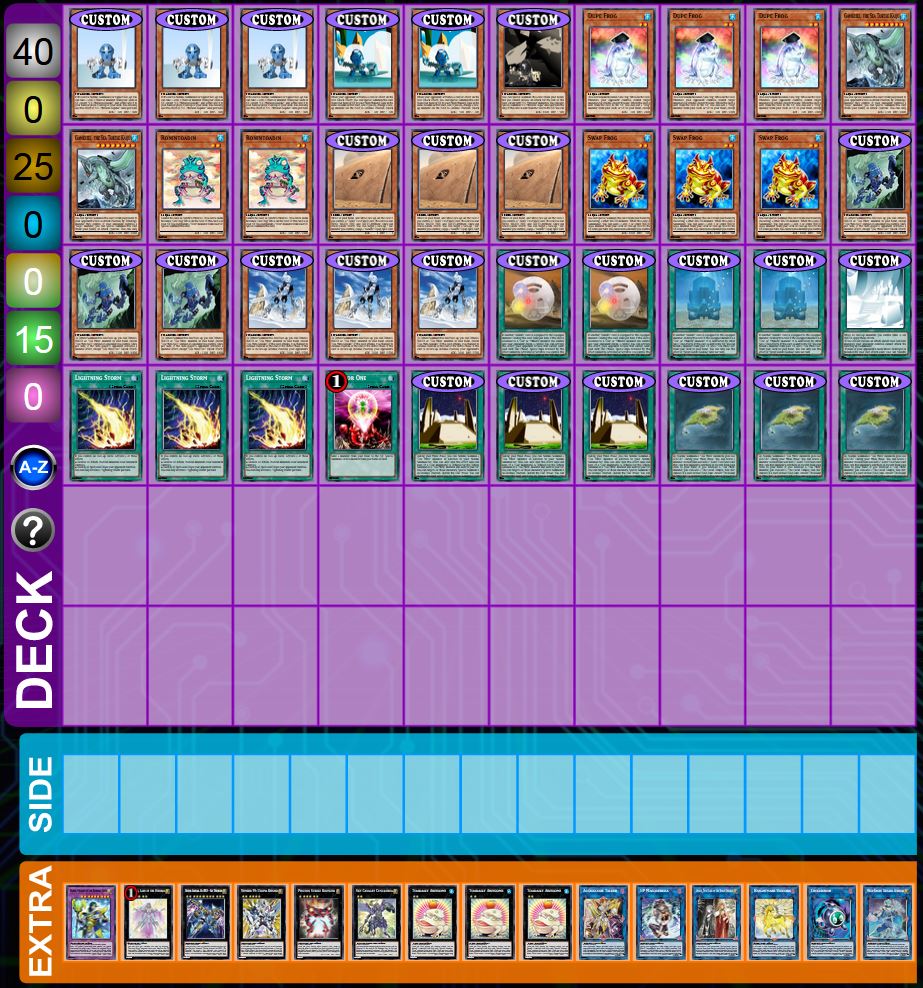At the time of this writing, the Toa Mata have yet to receive their Theme Guide, because even with all members of the team implemented, they’re still missing some support cards from old BCOT that have a major role in their playstyle. However, to modernize those missing cards, I do need to have a solid idea of what the updated Toa can do and what they need help with, so I have been experimenting with a few different builds using what we have so far. This is a brief account of those ideas and the rationale behind them.
The Kanohi Build
This one was included with the 3.17.4 release, and represents what is probably the most functional way to play “pure” Toa Mata at this point. The sole combo it revolves around requires a hand of any 2 different Toa Mata plus Kini-Nui (or Mata Nui to search it): Activate Kini-Nui, Normal Summon one Toa by Tributing the other one from your hand, trigger Kini-Nui to revive the Tributed monster, and use the two Toa to make Isolde, searching another Toa for the next turn. Then, you activate Isolde for 6 and watch your opponent quiver in fear at the sight of such a power move while you send all the Kanohi to the GY and Special Summon a Toa Mata from the Deck. The sent Kanohi let you add two more Toa of your choice by banishing the materials used for Isolde, the extra Normal Summon from Kini-Nui means you can get one of those out right away if you wish, and during the End Phase Kini-Nui can summon a Suva from the Deck by destroying itself, which will also bring a Mata Nui in your GY (if there is one) back to the field.
In summary, the turn 1 payoff consists of:
- 2 Toa Mata with at least 2000 ATK, each providing a more or less potentially disruptive trigger effect during the opponent’s turn (such as monster effect negation, Spell/Trap destruction, bouncing monsters, or returning cards in the GY to the Deck)
- A Suva that lets you access any of the 6 Kanohi in your GY to buff your Toa Mata with things like protection from either targeted or non-targeted effects, battle protection, or simply +1000 ATK.
- Isolde (largely useless at this point, but still there)
- 1 Toa Mata in your hand (searched by Isolde)
- Optionally Mata-Nui, which gives your Normal Summoned Toa Mata +600 ATK/DEF
- The 2 other cards that were initially in your hand
Going second, the deck has some convenient properties that may help it do its thing in the face of an established board. First of all, 18 of the 21 monsters it plays have 2000 or more ATK and don’t take any field setup to bring out, so sometimes you can just Normal Summon, immediately hit over a boss monster, and then safely do the combo in Main Phase 2. Also, if the monster you Normal Summon to trigger Kini-Nui is Gali, she will be able to negate one of the monsters on the opponent’s field to prevent interruption (but doesn’t do anything against handtraps, sadly). Lewa can also help clear the field because he’ll be able to bounce something when you summon your Suva (whether from Deck or GY).
If you don’t manage to pull off the combo, what you usually fall back on is still a boss-sized monster that may or may not have meaningful disruption and/or protection, which may just be enough to keep you in the game. And with the Kanohi constantly repleneshing Toa Mata in your hand plus Mata Nui being able to search Kini-Nui every turn, you should be able to try again easily.
Can a deck that puts up 2 disruptions at best, needs intensive micro-managing to achieve protection, and has almost no room to run staples be called good? Probably not. Does it do its thing impressively well for having no major plays beyond a (more or less) 3 card combo? Yes. I rate it “Isolde is a stupid card”/10.
Aristotlean Hybrids
The following decks are all based on the idea of combining the Toa Mata with other archetypes that also have their monsters spread across the Attributes WIND, WATER, FIRE, and EARTH. The idea is basically to perform the usual plays of such an archetype X, ideally get a Kanohi into the GY along the way for a search, and then use either a leftover Normal Summon or the extra one from Kini-Nui on a Toa, adding an extra miniboss or even a Rank 6 to the field. The matching Attributes are meant to help consistency by letting you use excess monsters from archetype X in your hand as Tributes for the Toa Mata, though in practice it certanly felt like hands such as Tahu plus anything except another FIRE monster were way more common than they should be.
The order in which the decks appear in the slideshow above is also an approximate ranking of their playability, ranging from actually kinda decent to complete garbage. The ratios in the Toa Mata portion differ between them because I threw them together at various points in time and never tested them deeply enough to figure out what’s best.
A quick summary of each of these ideas:
- C.C. Matoran: The most lore-friendly of all builds, and quite competent due to both halves being Warrior archetypes. Normal Summoning Kopeke gives you easy Isolde access by searching either Taipu (at the cost of an attack lock) or Tamaru (at the cost of only putting 1 monster in the GY instead of 2), and Isolde can then dump 2 Kanohi to search up to 2 Toa Mata and Special Summon Hafu, who will in turn bring out an additional C.C. Matoran from hand or GY. That gives you the material for a Link-4, and if you have Kini-Nui, a Toa Mata or two to back it up as well.
- Prank-Kids: The problem with Kanohi being the main searcher for Toa Mata is that you first need to put both the Kanohi and a monster into the GY. A Link-1 is quite possibly the easiest way to accomplish that, and Prank-Kids are an archetype notoriously capable of getting ridiculous value through a simple combo that starts by summoning their (now sadly limited) Link-1 monster. Better yet, the combo doesn’t care if the Prank-Kids stay in the GY beyond their activation as long as you ultimately end up with WIND+FIRE+WATER in your hand or field ready to fuse, so banishing them with a Kanohi along the way is pretty much a free Toa Mata. Only downside is that Prank-Kids usually take up the Normal Summon, but that’s what Kini-Nui is for.
- Brave Token: The OCG’s recent hot meta thing, the Brave Token AKA Adventurer Token AKA Isekai Engine, also has the correct Attribute mix, and actually gets by with no Normal Summons needed. In fact, it actively discriminates against Normal Summoned monsters by making you unable to activate their effects the turn you use the engine, but since your Normal Summon is going to be a Toa Mata that generally reacts to something during your opponent’s turn, this restriction is quite stomachable. My impression of the deck is that it works, but the Toa Mata’s contributions of big stats, situational disruption, and Rank 6 access unfortunately feel a bit overshadowed by the insanely consistent omni-negate engine that is Brave Token.
- Kaiju: The main idea behind this one, Attribute matching aside, is that Special Summoning a Kaiju to your opponent’s field triggers Lewa to bounce it back, which is obviously a pretty cool play. Sadly it doesn’t do much more than that plus plain old beatdown, and that’s not quite enough to win unless you get really lucky.
- Ghost Girls: Stuffing leftover deck space with handtraps is a well-tested competitive strategy, so I figured I’d try doing that as well, using the ones that have the appropriate Attributes. Sadly those particular handtraps aren’t exactly impactful enough to totally prevent an opponent from bringing out anything a big beatstick can’t deal with, so it doesn’t quite see the same results here as it does in actual meta decks.
60 Card Monstrosities
Another archetype with all the right Attributes I tried out was Nemeses, however they are not featured in the previous section because I ran into a bit of a problem: Just like the Toa Mata don’t really do anything unless you can get out multiple and/or set up your GY with a Suva and several Kanohi, Nemeses don’t really do anything unless you get some monsters banished first. And since the main way to get monsters banished also relies on sending Kanohi to the GY, neither half of the deck is particularly capable of getting itself or the other started despite having good synergy once they’re running.
In trying to resolve this, I attempted stuffing a bunch of extra “spicy” techs into the deck, eventually blowing it up to a pile of 60 cards that somewhat reliably worked.
Aside from the obvious, the most significant addition here are probably PSY-Framegear Gamma + Driver, as a powerful handtrap that conveniently can also set up some banished monsters for Nemeses plays. Driver also happens to be Level 6, so you can use it to pay the cost of Celestial Observatory and feel like an absolute king. However, at the end of the day, these additions only bring a slight reduction in the amount of luck you need to actually set up the really good plays, so I took a second stab and tried to fill up the 60 cards by bringing in a third archetype instead.
C.C. Matoran proved quite competent at quickly dumping a few Kanohi to the GY when I previously tried them as the sole partner archetype for the Toa Mata, so I figured adding them might be a fine way to handle the observed issues with getting the deck to its initial velocity. And it does indeed seem like doing the good old C.C. Matoran play of letting Isolde send 2 Kanohi to the GY provides just enough setup for both the Toa Mata and the Nemeses portion to perform actual plays. Maybe it would even be possible to condense this triple mix down to 40 cards somehow, but I haven’t tried.
Single Attribute Soup
A common problem with the mixed-Attribute decks was getting Toa without any of the right Tributes, so to bypass that issue I also tried building a deck that only uses Toa of the same Attribute along with matching support. The candidates for that would be WATER (Gali and Kopaka) or EARTH (Onua and Pohatu), and I picked WATER because then I can also incorporate Kopeke for that sweet C.C. Matoran Isolde combo.
The rest is just Frogs as a compact WATER package with a pretty good payoff, plus a single Ko-Koro to search with Mata Nui. Because I guess falling back to stall in cases where you don’t have anything else might at least keep you alive.
My verdict on this after a brief test run is that it can definitely do something more consistently than the decks that try to make multiple Attributes work, but what it does tends to be less impressive. For example, playing only 2 Toa gives you much less Rank 6 access via Kini-Nui, and even summoning one plus a Suva doesn’t do as much when the Kanohi selection is limited to Akaku and Kaukau. Also, I don’t really like it in concept, because the only reason there even are multiple Toa with the same Attribute is because ICE and STONE aren’t a thing in Yugioh.
Takeaways
The difference between a worthwhile experiment and a waste of time lies in whether or not you learn something in the process, so after trying all this, we face the big question: What does it tell us about Toa Mata and their future design requirements? I will end this on a quick summary of my observations, don’t hesitate to tell me in the comments if you feel I missed something.
- There need to be more ways to get at least two Toa on the field. Kini-Nui is nice and quite accessible now that Mata Nui exists, but even assuming you find it every game, it’s still a gigantic choke point and negating it might just end your turn on a single big monster with a moderately useful effect.
- Continuing from that last point, a single Toa Mata should provide a bit more value than it currently does. I kinda made this harder for myself than it needs to be by deciding the standard archetype support effects (searching, revival, etc) should be supplied only by support cards (and eventually Extra Deck monsters) rather than the main monsters themselves, to represent the Toa starting out as scattered amnesiacs before gathering towards the climax of the ’01 story. We’ll see if I can get away with sticking to my guns there.
- A mix of all the Toa plus another engine/archetype that covers the same Attributes isn’t as good as expected, probably because it gives you more wrong ways to combine Attributes than right ones. As far as Toa Mata Tribute fodder goes, other members of the team or the multi-Attribute (in the hand) Suva have proven to be far more reliable options.
- Early in the duel, going into Isolde with two Toa Mata and dumping all your Kanohi seems way better than making any Rank 6, which always bothers me a bit. I’d like to design the archetypal Xyzs to provide more value than even that, but it’s hard to imagine a way to do that without getting ridiculous. Maybe the better solution would be introducing additional ways to set up Kanohi, since Isolde is only so crazy good while you haven’t done that yet.
- Another problem with making a Rank 6 out of Toa is that it usually removes all the Toa on your field, which takes away their potentially disruptive effects, Suva access, and Kanohi benefits. Isolde at least can give you another Toa by dumping 6 Kanohi, so it’s less of an issue there. This honestly might be resolved just by the fact that the upcoming dedicated bosses will also have “Toa” names, but I already have some ideas how this point could be addressed even further.
- The banishing cost I somewhat spontaneously added to the Kanohi searches so stuff like Isolde wouldn’t get out of hand too much comes with some interesting practical challenges. On the one hand, the fact that you need to get both the Equip Spell and a monster into the GY makes them too unreliable to really act as the archetypal search cards, not to mention they can only get one specific monster each. On the other hand, if you do get them going, and especially if you get a Toa Mata + Suva setup where potentially every Kanohi swap translates to a search, you end up accumulating a lot of banished monsters that don’t really have any use if you’re not playing specifically a Nemeses hybrid. Not sure yet if it makes sense to add support that takes advantage of the big banished pile, since it tends to only exist when you’re already popping off anyway.

